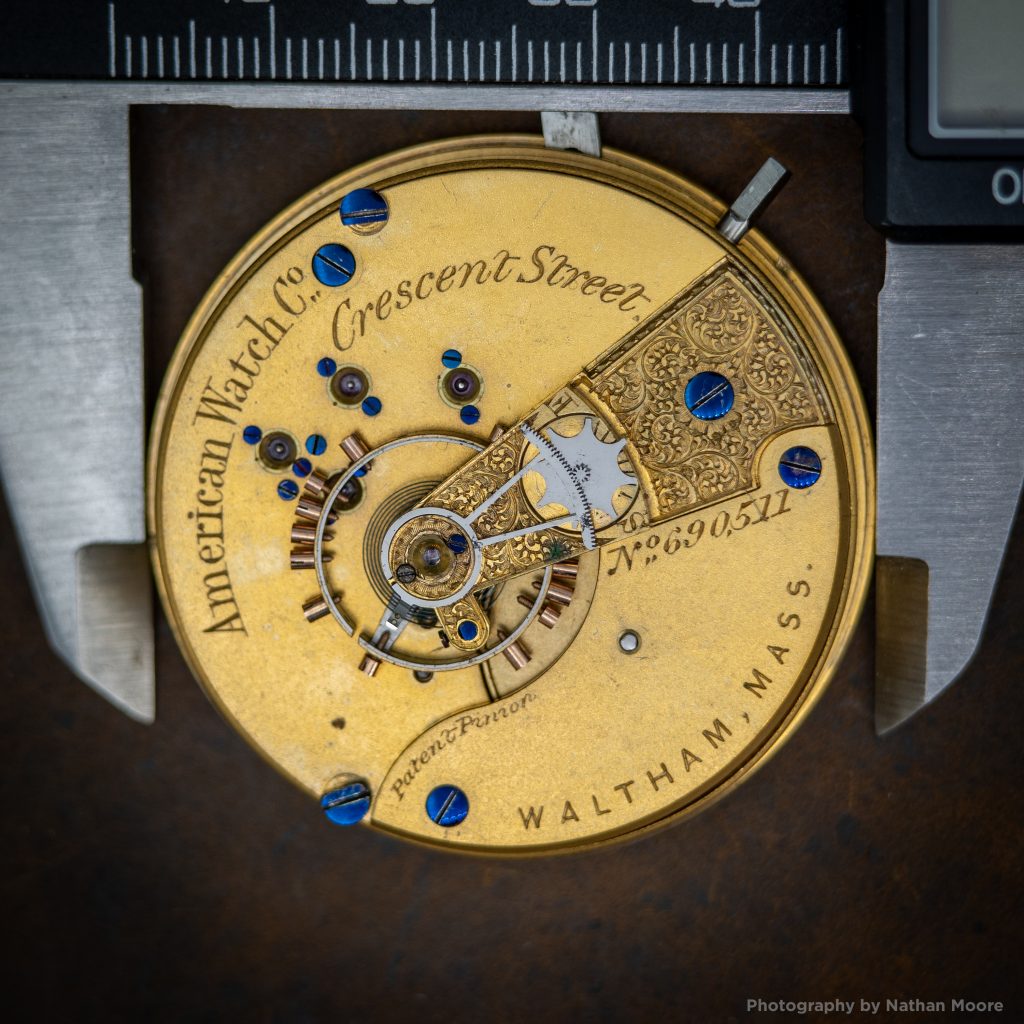The Waltham “Crescent Street” Movement: The Model 1870: “New Shape and Caliber”

During this article series, we have explored the introduction of the Model 1870 Crescent Street as the American Watch Company’s first watch specifically designed for railroad service.
One intriguing description provided in early advertisements promoting the Crescent Street suggests the Model 1870 was sized differently than the standard 18-size movements on the market:
“Being of a new shape and caliber, it will not fit the regular Waltham full plate case, and casing blocks will be supplied as usual.”

Pillar Plate Diameter
So, how does the Model 1870 compare to other 18-size movements from the same era?
The diameter of the pillar plate (where the dial is attached) is the most critical measurement used to determine the size of the movement. According to the Lancashire Gauge, the standard size of an 18-size movement is 1.80″—or 45.72mm. It should be noted that the models designed by American watch companies did not always strictly adhere to this gauge, so some variance is expected. The cases manufactured for American movements typically offered some tolerance to account for this variance.

The Model 1870 from the Waltham factory features a pillar plate width of 45.86mm – slightly wider than the standard 18-size presented by the Lancashire Gauge.
However, a sampling of other 18-size movements from slightly before and after the introduction of the Model 1870 suggests that this measurement is within the general expected tolerance. Even so, the Model 1870 is nearly a millimeter wider than its predecessor – the Model 1857.
c.1864 Waltham Model 1857 Wm. Ellery #127129: 45.78mm (+0.06mm)
c.1867 Elgin BWR #829: 45.81mm (+0.09mm)
c.1871 NYWCo John Hancock #20231: 45.85mm (+0.13mm)
c.1872 Waltham Model 1870 Crescent Street #690511: 45.86mm (+0.14mm)
c.1877 Rockford #10303: 45.62mm (-0.10mm)
c.1882 Waltham AT&Co. #1744576: 45.86mm (+0.14mm)
Movement Thickness
The thickness of the movement was the other key measurement that dictated the case size. Unfortunately, movement thickness was not expressed in any standardized gauge. The “standard” thickness was a measurement that morphed during the development and adaptation of the American watch industry. Cases manufactured in earlier eras would generally accommodate thicker movements.
c.1864 Waltham Model 1857 Wm. Ellery #127129: 11.96mm
c.1867 Elgin BWR #829: 11.82mm
c.1871 NYWCo John Hancock #20231: 10.45mm
c.1872 Waltham Model 1870 Crescent Street #690511: 12.10mm
c.1877 Rockford #10303: 12.03mm
c.1882 Waltham AT&Co. #1744576: 12.45mm
Again, the Model 1870 is thicker than its predecessor by approximately 0.14mm.

Top Plates
The most consequential sizing difference when comparing other movements on the market is apparent when measuring the diameter of the top plates. The Model 1870 Crescent Street measures a full millimeter larger than the other 18-Size movements offered at the time.
c.1864 Waltham Model 1857 Wm. Ellery #127129: 42.7mm
c.1867 Elgin BWR #829: 42.68mm
c.1871 NYWCo John Hancock #20231: 42.68mm
c.1872 Waltham Model 1870 Crescent Street #690511: 43.7mm
c.1877 Rockford #10303: 44.39mm
c.1882 Waltham AT&Co. #1744576: 43.86mm

Rationale
The reason for the larger measurements is unknown. Perhaps the features of the new model demanded a design adaptation. Another feature mentioned in early advertisements was the attachment of the dial using screws (instead of pins), which may have required additional thickness to the pillar plate.
Or, since the American Watch Company was manufacturing cases at the time, they strategically positioned the movement to require a special fit case, which the company conveniently supplied.
Regardless of the motivation, the Model 1870 helped usher in new sizing conditions for 18-size cases. As the trends shifted, more movements were introduced with slightly larger upper plates and thickness, similar to the Model 1870 – and more companies produced cases to accommodate these movements.
This also makes finding a Model 1870 Cresent Street in its original case a critical factor for collectors, especially for watches with winding stems and setting mechanisms.
Measurement Data
| Watch Movement | Serial Number | Est. Production Year | Pillar Plate Diameter (mm) | Thickness (mm) | Top Plate Diameter (mm) |
|---|---|---|---|---|---|
| Waltham Model 1857 Wm. Ellery | 127129 | 1864 | 45.78 | 11.96 | 42.70 |
| Elgin B.W. Raymond | 829 | 1867 | 45.81 | 11.82 | 42.68 |
| New York Watch Co. John Hancock | 20231 | 1871 | 45.85 | 10.45 | 42.68 |
| Waltham Model 1870 Crescent St. | 690511 | 1872 | 45.86 | 12.10 | 43.70 |
| Rockford “C” | 10303 | 1877 | 45.62 | 12.03 | 44.39 |
| Waltham AT&Co. | 1744576 | 1882 | 45.86 | 12.45 | 43.86 |



